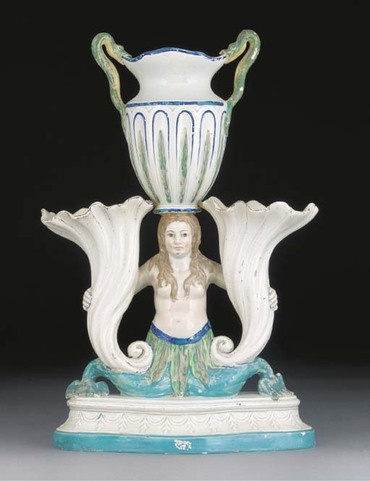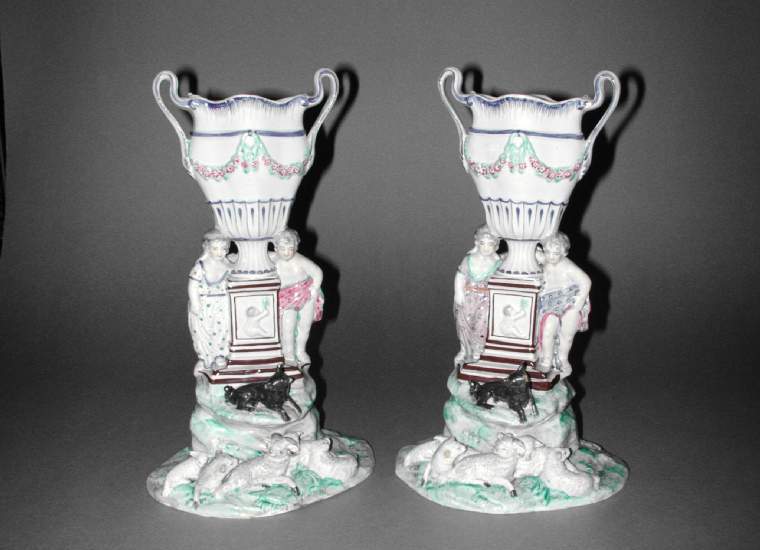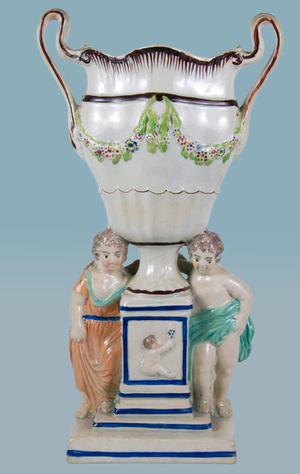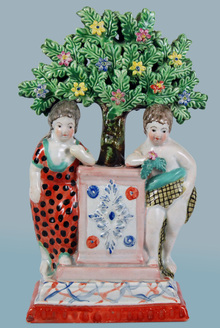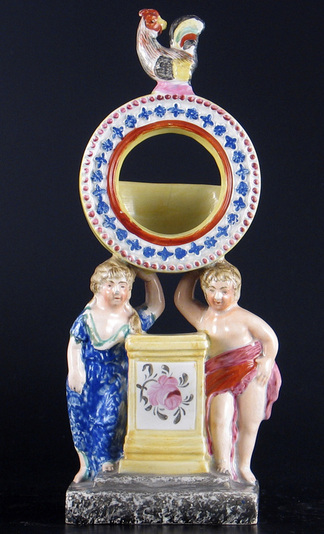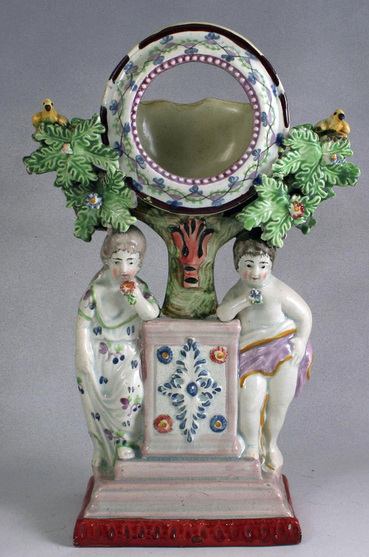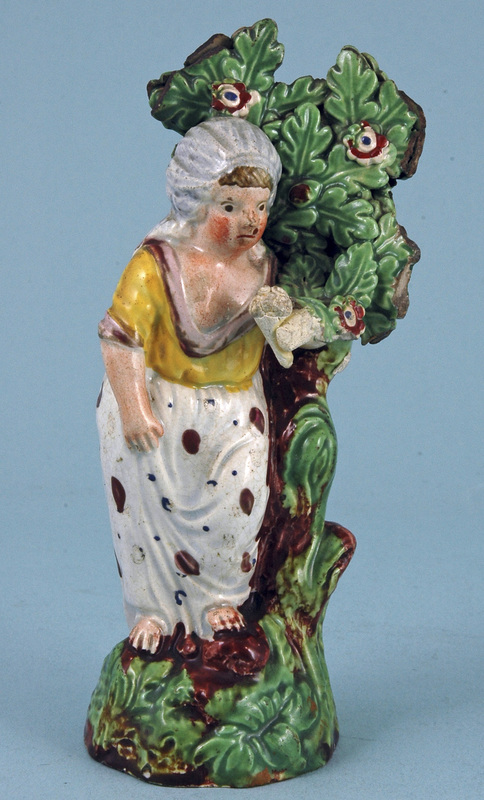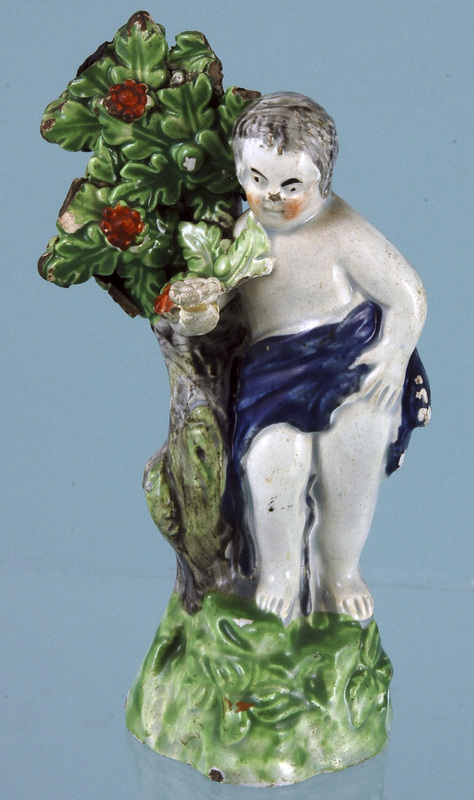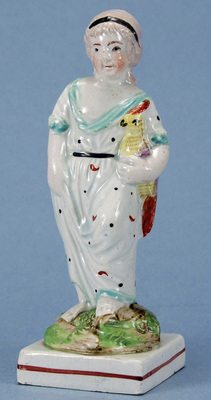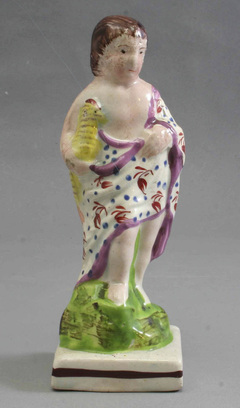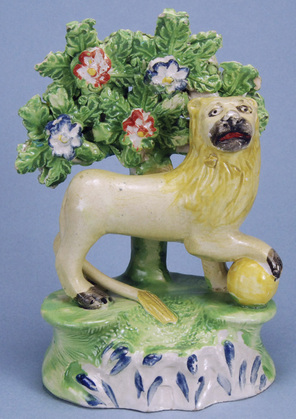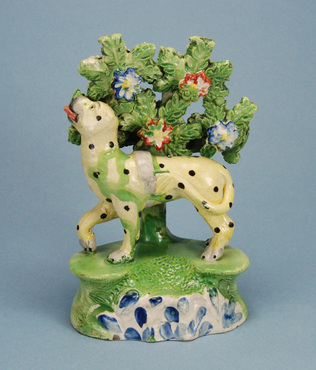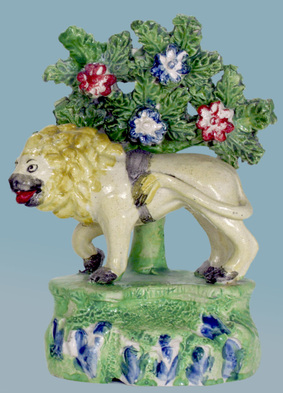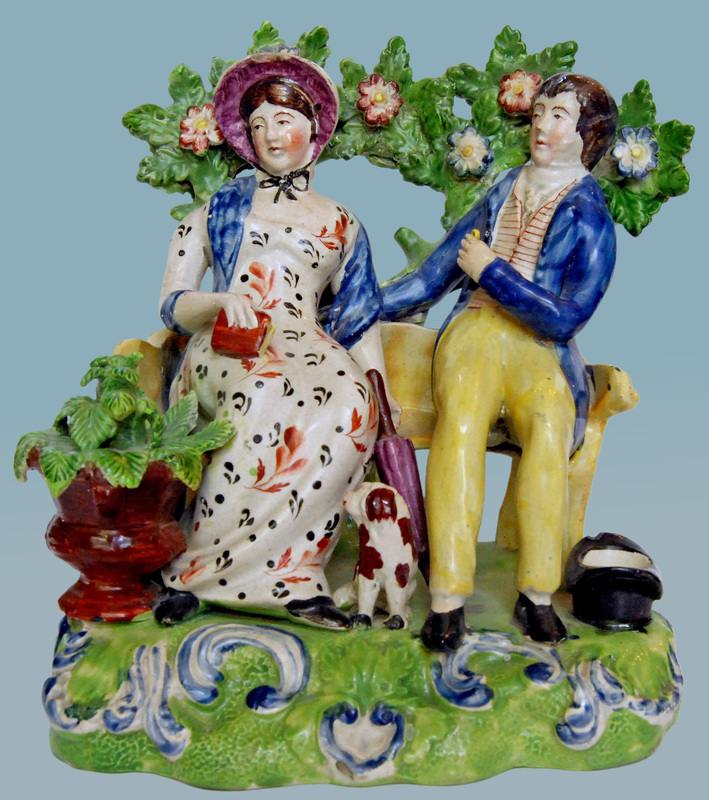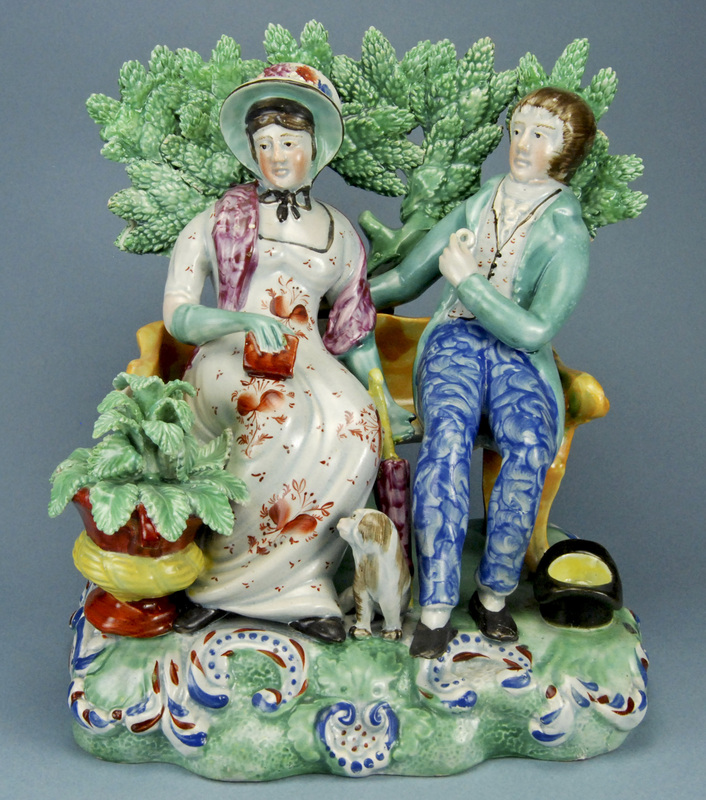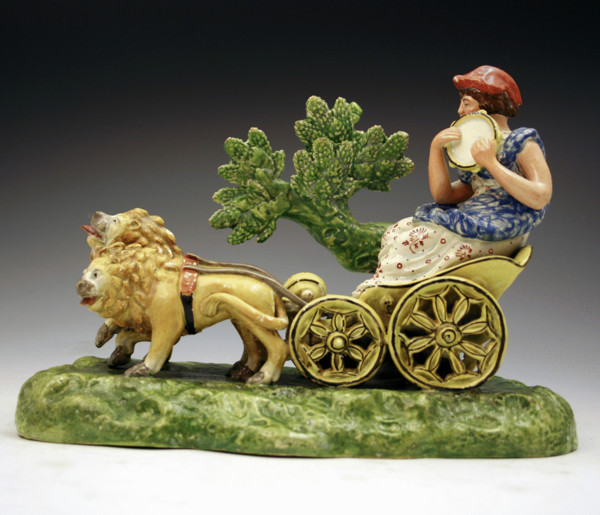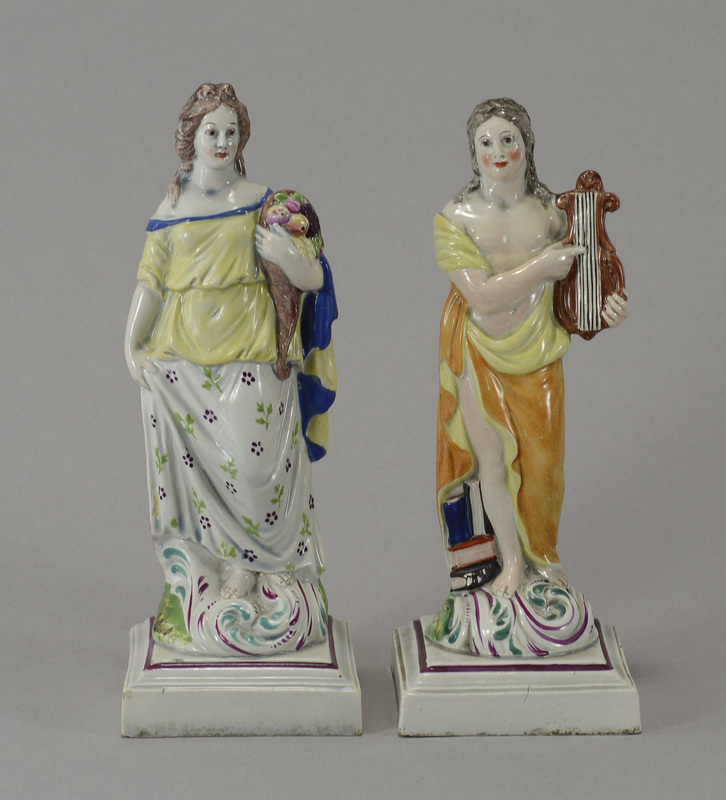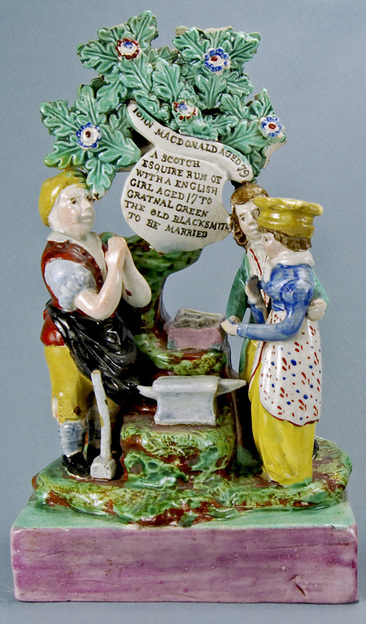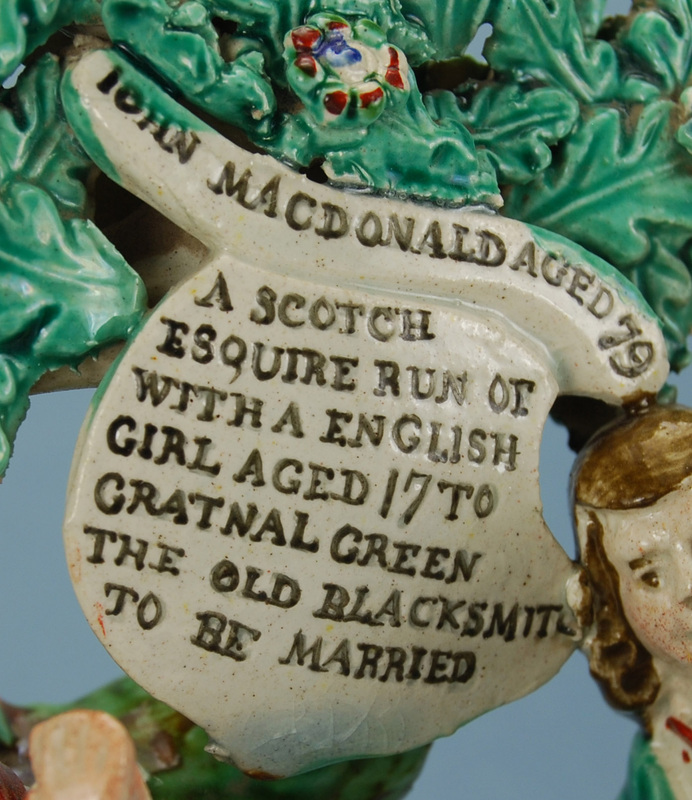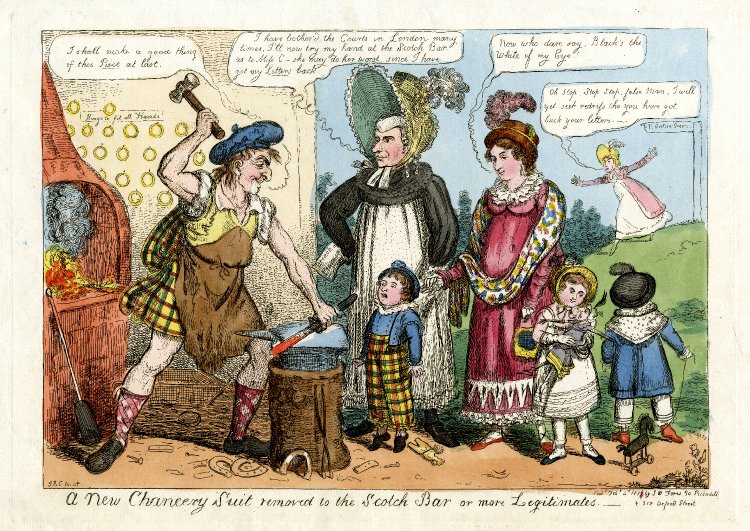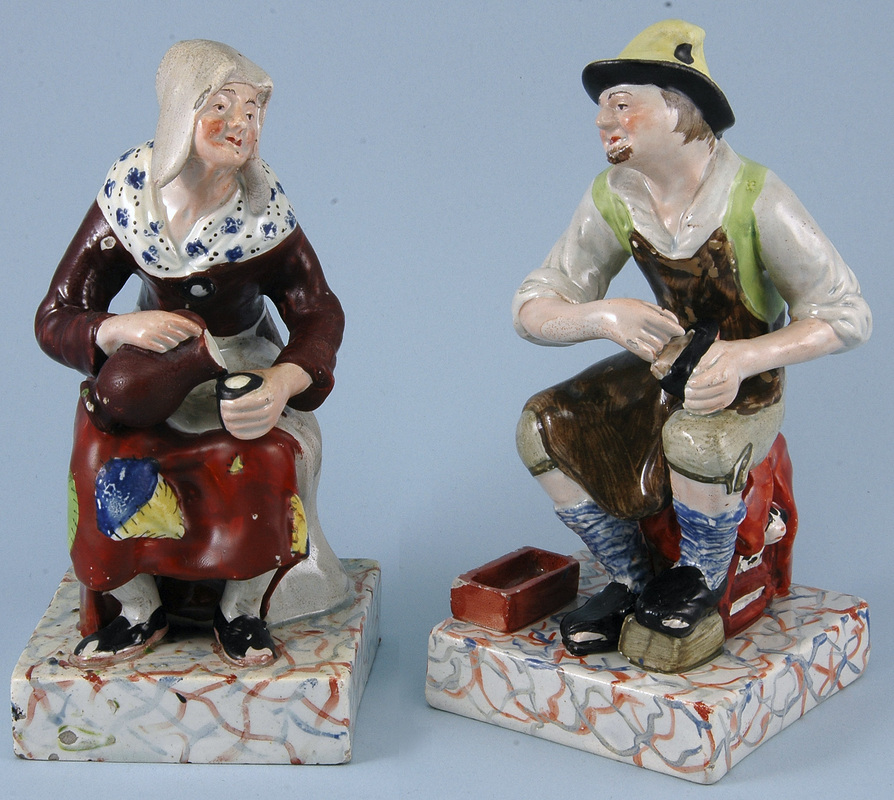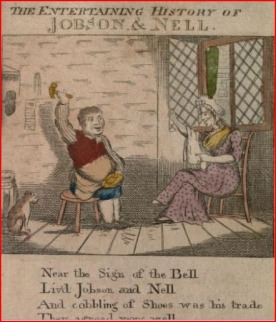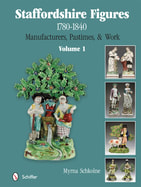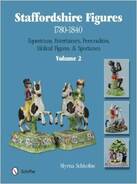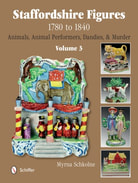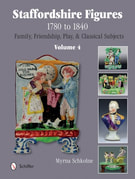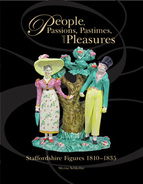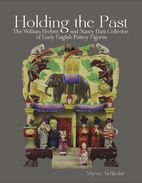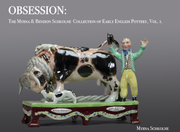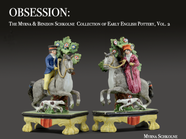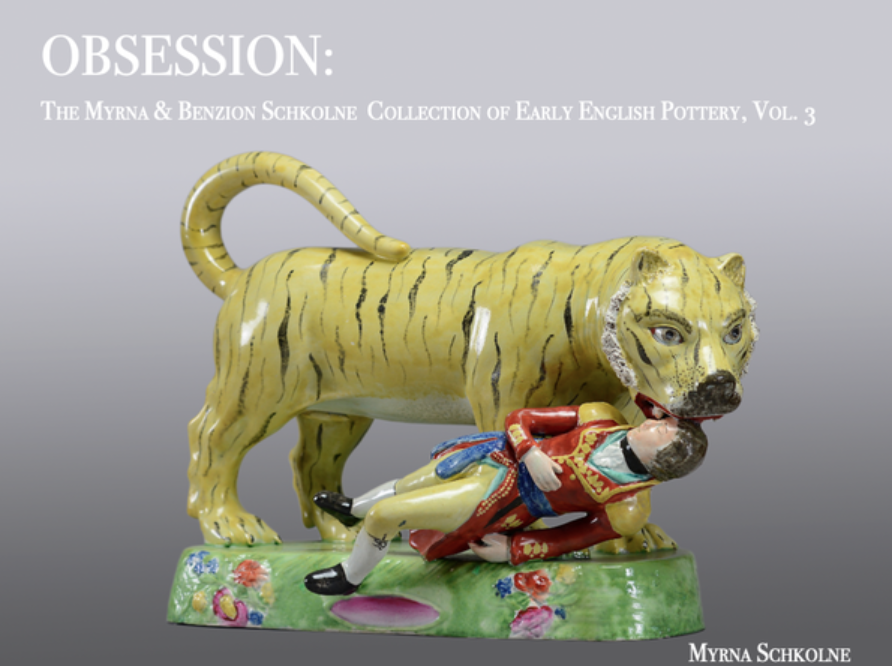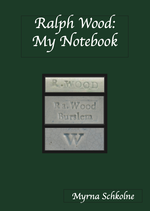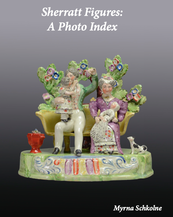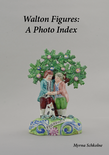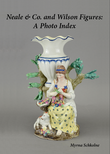Below, is a pair of superb vases in the collection of the Fitzwilliam Museum. The vases are of the same form as that atop the mermaids head, above. However, this time the handles are more subdued....no snakes' heads! I would date this pair as circa 1790.
|
I was thrilled to stumble upon this fantastic vase in cyberspace recently. It sold at Christies more than 10 years ago. Alas, I have not seen it in the flesh, nor any other like it. The central figure is, of course, a rather tubby mermaid, and, in keeping with that theme she holds two shells. Also, the handles of the vase are modeled as snakes...sea serpents, I suppose. At 13 inches in height, it is quite wondrous. The colors and the form of the vase make it instantly recognizable as no later than about 1800. Below, is a pair of superb vases in the collection of the Fitzwilliam Museum. The vases are of the same form as that atop the mermaids head, above. However, this time the handles are more subdued....no snakes' heads! I would date this pair as circa 1790. The vase below is of the same form as the vases above. Again, it is early, circa 1795. Photo courtesy of Elinor Penna. Vases of this form seem to have faded into obscurity around 1800, but Staffordshire potters cleverly recycled the figure molds. Here you see the same plinth and figures assembled to make an appealing figure group, circa 1820. Of course, a good plinth should not go to waste, and below we see the same figures and plinth with a watch stand atop this time. Photo courtesy of Woolley and Wallis. And here we have another, but with bocage leaves added. Photo courtesy of Martyn Edgell. The little children to either side of the plinth are also found as separate figures, appearing here courtesy of Andrew Dando. And, as you see below, these figures "evolved" to sometimes hold birds. (RHS figure courtesy of Martyn Edgell) There was no limit to the Staffordshire potters' ingenuity in reusing molds, and we could take this trail further and further. But what of the mermaid that started this discussion? I wish I could show the mermaid to you in other contexts, but at this point I know of no other. I can't believe that the molds did not get used again and again, so I live in hope. If you have her, or anything like her on your shelves, please share.
2 Comments
The little lion above is a very old favorite in my collection. I have had him for over 20 years and have never seen another. To keep him company, I stand him alongside the leopard, below. They make rather a pleasant pair, but they are not a true pair. The true mate of this rather dog-like leopard is another leopard, and I have him in my archive, if not on my shelf. Clearly, the lion and leopard are from the same pot bank. Note the same bocages on each, as well as the same bases. Below, we have yet another lion from the same pot bank. Again, the bocage and base are the same. If you were to have these figures in front of you, you would see that the enamels have the same look and feel. This lion, henceforth lion #2, does have a mate, so here it is possible to make a true pair. The pot bank that made the lions and leopard above also made other animal subjects in the same style. There are cows, horses, sheep, deer, dogs, and goats...a veritable menagerie. The large, seven-petaled bocage flowers on all these figures are the significant because only one pot bank made these bocage flowers. Figures from this pot bank form a cohesive group, and I use the term "Patriotic Group" to define it. Pat Halfpenny first suggested that the term "Patriotic" for figure groups with a certain look--in particular, Pat noted the swirls on the bases are sometimes (not always) decorated in red, white and blue. For example, the well-known Perswaition groups often have bases decorated in this manner, and that's because they all were made by the Patriotic Group pot bank. Below you see one. And yes, it has the same big, seven-petaled bocage flowers as ALL the animal figures above! Of course, the Patriotic Group pot bank used more than one bocage format, and so we find some of these figures with different bocages. Below is Perswaition again, but this time it has a pine cone bocage (and yes, the swirls on the base are in those oh-so-patriotic colors of red, white, and blue!) 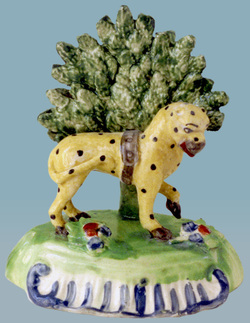 Similarly, some of the animals that we have seen here come with pine cone bocages. Alongside is a small leopard with a pine cone bocage. The pine cone bocage is exclusive to the Patriotic Group. No other pot bank used it. When you see it, you know that the Patriotic Group made it. (Yes, the base is different, but this is another base form that was used by the Patriotic Group pot bank.) Are you wondering what the leopard and lion #2 have on their backs? These are harnesses of a sort, and they are there because the Patriotic Group used these very same lion and leopard models to draw large chariots. Below, you see two lions (of the same type as lion #2) pulling a chariot. And the bocage is the pine cone bocage that is exclusive to the Patriotic Group. The Patriotic Group is big, and I could write a book on it. But I want to leave you with a reminder that last November we looked at the holly bocage that is also exclusive to the Patriotic Group . Please take a moment to revisit it by clicking here. Also, let's get back to the animal figures again. Please know that these are all very rare and in many cases are known from only one or so example. Lion #2 is the commonest form--but is a long, long way from being a common figure!
No earthenware figures, to my mind, are finer than the enamel-painted ones that manufacturers like Lakin & Poole, Ralph Wood, and Neale & Co. made in the final two decades of the eighteenth century. It's the yummy enamels that grab my heart every time. I would go as far as to say that the Neale enamels are my favorites. For that reason, I was thrilled to find a companion for my Neale figure of Ceres. Here they are: Are these not eye-candy? My long-loved figure of Ceres is on the left. Look at the puddle of blue glaze in the hollow of her throat. Apollo, on the right, is the new kid on my shelf. I bought him from Madelena two weeks ago. Each figure has its title impressed beneath. Neither has a maker's mark, but both are definitely attributable to Neale & Co--and indistinguishable from marked examples. We use the Neale & Co designation rather loosely to include the period when the Wilson family ran and then owned the pot bank. Ceres is perfect, and so is Apollo. No repairs of restorations on either one. To read the description of Apollo on Madelena's site, you might want to think twice before adding him to your shopping basket. Every little imperfection--most of them original to manufacture--was described in gory detail and shown at larger-than-life size. Notice the grungy edges around the bases of both figures? That happened from standing in the saggar during firing. As the figures stand now, you really don't notice it. Shown enlarged on Madelena's site....well, its a bit like looking at even the finest face in a 10X magnification mirror! Similarly, the tiny flakes on the black book next to Apollo's foot were illustrated at larger than life size. I have to applaud Madelena's honesty, but, frankly, I have often wondered WHY they do this. Last month, I got it! Somebody contacted me about a stunningly perfect figure they had recently bought. The issue was a tiny speck of white clay (think three grains of sugar) that had adhered to the front edge of the base. This collector lived happily with restored bocages and other atrocities, but this little white speck caused much concern. Collectors, if you are that fastidious, find something else to collect. You must expect your earthenware figures to show minor scuffing and wear. Please recoil in horror at a new bocage, but not at an old flake. And don't you think Apollo and Ceres look awfully good at the age of 230+? I recently came across this candlestick in a private collection. 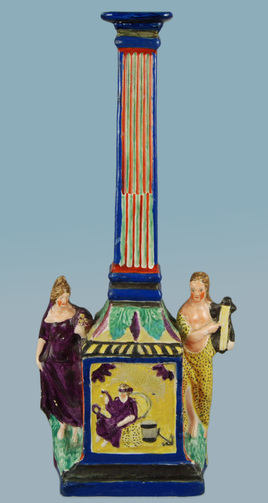 Isn't this a rather stunning object? Ceres stands to the left, and Apollo to the right. The only other example I have traced of this form is illustrated in Haggar. It is from the same molds but is decorated in underglaze colors and is inscribed "Wm Turner" beneath. Classical figures are not particularly "commercial" and, for that reason, they are underpriced today. That may not always remain the case. Remember, they can be fabulous additions to your collection at a price you won't regret.
I am sure that in some long-gone blog posting, we looked at Gretna Green wedding groups, but I particularly like the model that comes with a plaque. The inscription on the plaque is thought to refer to the elderly Lord Erskine, who eloped to Gretna Green with his young housekeeper, Sarah (sometimes referred to as Mary) Buck. The couple took along their three illegitimate children, but the story gets better: Lord Erskine is said to have traveled in disguise because he wanted to avoid his legitimate children, who were in hot pursuit, wanting to stop a marriage that might jeopardize their inheritance. And what did his lordship wear as a disguise. A wig, you might think? No, Lord Erskine wore "female cloaths with a "Leghorn Bonnet" & veil." Lord Erskine was the lord chancellor of Great Britain and the greatest trial lawyer in English history, and his hot-headed elopement stunned the nation. Of course, the tale grew as it spread, and it seems that Lord Erskine's clothing may just have been a figment of gossip-mongers' imaginations rather than an accurate account of what happened. In the same spirit, Staffordshire figure potters could not resist poking fun at Lord Erskine in clay, but they were not the only ones to capitalize on this tantalizing tale. Look at this amazing satirical print in the British Museum. The online catalog describes it thus: A (burlesque) Gretna Green marriage in an open-fronted smithy. Erskine, in woman's dress, wearing a huge feathered bonnet over a barrister's wig, holds the right hand of a demure-looking woman, modishly dressed and apparently pregnant. He holds a paper: 'Breach of Promise'. With them are three young children. The smith, in profile to the right, wears Highland dress; he holds a red-hot bar on the anvil and raises his hammer, saying, "I shall make a good thing of this Piece [cf. No. 10668] at last." Erskine says: "I have bother'd the Courts in London many times, I'll now try my hand at the Scotch Bar—as to Miss C— she may do her worst since I have got my Letters back." The woman says: "Now who dare say, Blacks the White of my Eye," showing that her origin is low, see No. 13081, &c. In the background (right) a young woman rushes down a slope towards the smithy, shouting, "Oh Stop Stop Stop, false Man, I will yet seek redress tho you have got back your letters—" Beside her is a sign-post pointing 'To Gretna Green'. A little boy with Erskine's features, wearing tartan trousers, stands on tip-toe to watch the smith; on the ground beside him is a toy (or emblem), a cock on a pair of breeches (cf. No. 13145). A little girl stands by her mother nursing a doll fashionably dressed as a woman, but with Erskine's profile. Another boy with a toy horse on a string stands in back view watching 'Miss C'. Behind the smith (left) is the furnace; on the wall hang many (large) rings: 'Rings to fit all Hands" 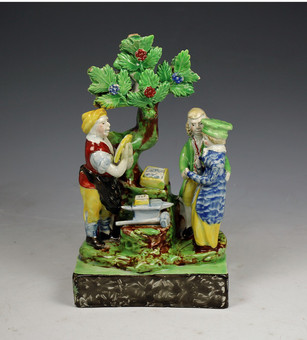 The same Staffordshire figure model was sometimes made without a plaque. Alongside is an example just added to John Howard's stock. I suspect that the model was in production when Lord Erskine and Miss Buck and the kids eloped--and the potters added a plaque to take advantage of the comic situation. So what happened to Lord Erskine and his new family? Alas, the story does not end well. By 1820, Lord Erskine tried to have his marriage ended, but in that era there was no divorce law, so he was stuck! By 1821, the Erskines had separated. In 1823, Lord Erskine died. By 1825, Sarah Erskine and her children were destitute, and she died shortly thereafter.
Am I the only person gnashing my teeth about the dirth of fine figures? We addicts need a periodic fix--if not to buy, at least to look. And, as I mentioned on the NEWS page the other day, a leading ceramics dealer recently said to me that now even figures of Jobson and Nell are rare. How true! There is a terrible shortage of figures coming to market, and dealer stock is dwindling. It had to happen. I think the Internet brought about a mass clear-out, so the current dry spell may be the new norm. With that awful thought, let's now give those much-maligned figures of Jobson and Nell a little respect. Figures of Jobson and Nell can be awful, and the subject hardly oozes charm. There are plenty of mundane examples (as the Internet has, fortunately or unfortunately, taught us)--hence the bad reputation. But to be fair, some Jobson and Nell pairs are simply lovely. This pair in the stock of Andrew Dando is, I think, as good as they get. There's nothing not to like here. Below is what I consider the commonest Jobson and Nell pair, but I would not turn my nose up at this couple. I was totally charmed by them when I handled them. They are so well modelled--quite delightful. They are in the Wisbech & Fenland Museum (which is well worth a visit) and are impressed "27" beneath, indicating that they were made by Enoch Wood. As you see, turned to the side, each figure has a small animal beneath the chair, as is typical on nearly all Jobson and Nell models. Is this not a lovely touch? 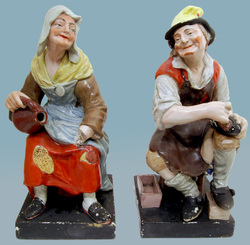 This pair alongside is in the Potteries Museum. Same pair again? Definitely not! Whereas the first pair (like most pairs) is about 6.5 inches, this pair is over 13 inches. Yes, Jobson and Nell were made in two sizes. The larger size is particularly uncommon--and this is a superb example. Jobson and Nell figures may not be the most commercially popular items ever, but, alas, at the start of the twentieth century they must have been particularly desirable because they were reproduced in abundance. Reproductions come in both the small and big sizes. They lack the fantastic modeling found in early pairs, and of course the color palette and crazing are usually a dead give away. Who are Jobson and Nell? Jobson is a lowly cobbler and Nell is his sweet wife. They starred in The Devil to Pay or, The Wives Metamorphos'd, a ballad farce first performed in 1731. Revivals were popular on the English stage into the nineteenth century. A performance was staged at Covent Garden as late as 1828, and even children's books drew from the theme and illustrated Jobson and Nell (see below for a page from a book published in 1825). You can see examples of Jobson and Nell from assorted pot banks in my forthcoming publication. Included are a pair marked "HALL" (for Samuel Hall), a pair with bocages, a few pairs with titles, and a pair with a possible connection to Rockingham. At the end of the final volume, a chapter on reproductions shows a later pair of Jobson and Nell figures alongside an early pair. In short, I have tried to do the topic justice. The first volume of my four-volume work will be out later this year, with the other volumes to follow.
|
Archives
September 2023
All material on this website is protected by copyright law. You may link to this site from your site, but please contact Myrna if you wish to reproduce any of this material elsewhere. |
